This website uses cookies so that we can provide you with the best user experience possible. Cookie information is stored in your browser and performs functions such as recognising you when you return to our website and helping our team to understand which sections of the website you find most interesting and useful.

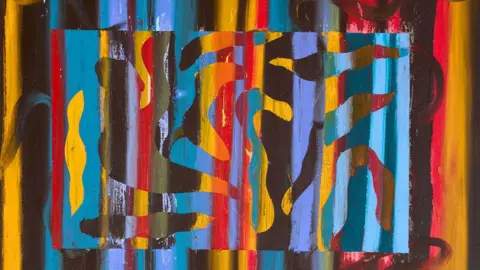 Rocio Chacon / Ed Cross Gallery
Rocio Chacon / Ed Cross GalleryOne day when struggling to get to grips with a spreadsheet to calculate his annual budget for art supplies, an idea popped into the mind of Ghanaian visual artist Joseph Awuah-Darko.
He could use the database to track his bipolar disorder, a mental illness that causes huge swings in a person's moods, energy and concentration levels.
“I'm a visual learner and I thought: 'Why don't I use colour as a language?'” Awuah-Darko told the BBC.
"Colour allows me to express things that I can't really capture in words.”
The 28-year-old started allocating to every hour a colour that represented how he was feeling at that point in time - with red being the most depressive state, and pastel blue the most positive.
“It became something that became addictive - and cathartic. And an interesting way of monitoring my life.”
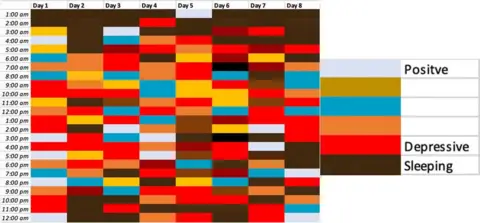 Joseph Awuah-Darko
Joseph Awuah-DarkoOut of those meticulous digital records, the artist has also created a series of abstract oil paintings - portraits of his days.
His first UK solo exhibition, How’s Your Day Going?, “makes exterior” his struggles with bipolar disorder, with which he was diagnosed at the age of 16 when he had a breakdown at school.
Some days are better than others, as the blocks of colour in his worksheets show.
He uses oil sticks to create vertical linear stripes on the canvas - in blacks, browns, reds, oranges, yellows, blues and greens.
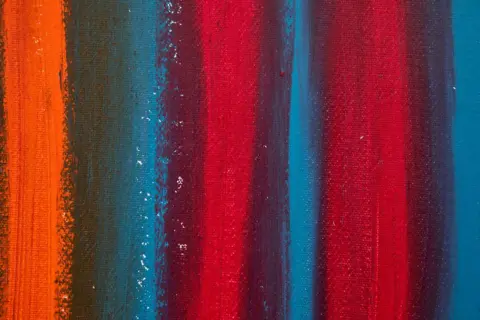 Rocio Chacon / Ed Cross Gallery
Rocio Chacon / Ed Cross GallerySome paintings are almost as neat and precise as the coloured spreadsheet cells - others are less ordered.
The artist does not wait for one paint to dry before he applies the next colour - and as the wet paints run into each other, new colours are created.
This mixing, says Awuah-Darko, reflects the nuances and complexities of his own emotions.
"It's beautiful to see how, even though I have given these strict schematic colour assignments to my moods, emotions aren't sanitised,” he says.
“They are messy, and they flow into each other,“ he says.
Awuah-Darko was born in London to Ghanaian parents, but he grew up in Ghana, has travelled a lot and now lives in the Belgian capital, Brussels.
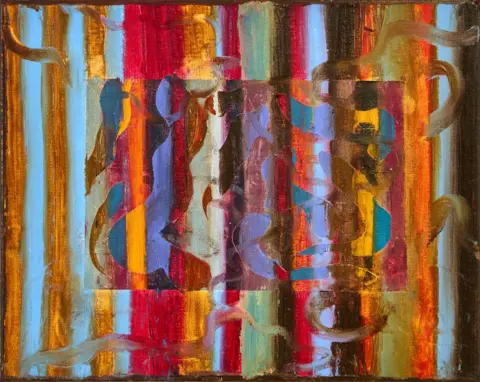 Rocio Chacon / Ed Cross Gallery
Rocio Chacon / Ed Cross GalleryThe colours he uses to capture his emotions depend on where he is in the world - and partly reflects “the nature of what I feel about the environment I'm in”.
The deep, warm blue-green of teal is a colour that he most associates with Brussels.
Teal covers a whole range of emotions and energies that he feels - somewhere in the middle between the deep, disruptive depression of red and the positivity of lighter blues.
He often paints while in “a state of teal”.
“I'm deep in thought and lost in the void of my own imaginations,” he says.
“I’m not exactly bursting with joy,” he laughs,” but I am engaging my mind and my hands in a way that I feel is productive.”
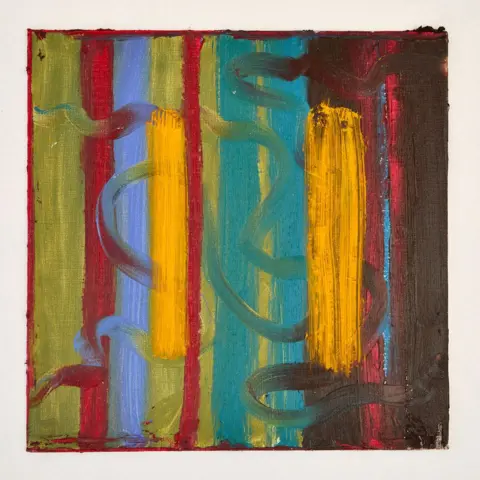 Rocio Chacon / Ed Cross Gallery
Rocio Chacon / Ed Cross GalleryYellow is what Awuah-Darko describes as “a nuanced state of anxiety”. It could be a moment of disappointment or rejection.
"It's not an absolute negative,” he says, “but it is something that could break you down - if you chose to allow it to.”
The first painting Awuah-Darko created in the How’s Your Day Going? series is entitled June 15 PM.
The date is the day recorded in the spreadsheet - and “PM” reflects that he finished the painting at night.
The image holds particular “emotional gravitas” for the artist because he says it is when he accepted that his life was going to be based for the foreseeable future in Brussels - not Accra, Ghana’s capital.
 Rocio Chacon / Ed Cross Gallery
Rocio Chacon / Ed Cross GalleryAwuah-Darko left Ghana because he wanted to live openly as a gay man - and he felt he could not do that because of restrictive legislation passed by Ghana’s parliament in February 2024.
The bill - which is yet to be signed into law by the president - imposes heavy sentences on gay, lesbian and bisexual people, anyone who identifies as transgender, as well as those seen as allies.
“I created June 15th at a time when I was really reconciling with what it meant to be an immigrant. That was daunting, heavy, beautiful and exciting.”
Awuah-Darko was inspired to transform the “spreadsheet diaries” into paintings by a two-month artist residency he attended earlier this year at the Josef and Anni Albers Foundation in the US.
The late German-born American artist Josef Albers put colour at the centre of his work and has inspired generations of artists.
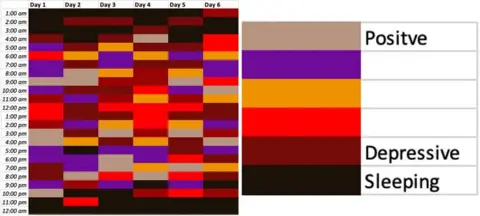 Joseph Awuah-Darko
Joseph Awuah-Darko"At the residency, I learned about the power of colour as language, as vocabulary, and it really enhanced my ability to capture that in my abstract painting.”
Awuah-Darko also pays homage in his art to the bold and colourful work of Atta Kwami - one of Ghana’s most respected artists who came from Kumasi but spent many years in the UK where he died in 2021.
“There's such an honesty about his painting and such a reverence for the colours he uses, which are so linked to his upbringing in Ghana and to how he viewed the world through lines and spaces.”
Another influence is Anni Albers, one of the world’s leading textile designers and printmakers, and wife of Josef Albers, who blurred the lines between the ancient craft of hand-weaving and modern art.
Awuah-Darko drew on Albers' work for his most recent paintings - and also his own heritage.
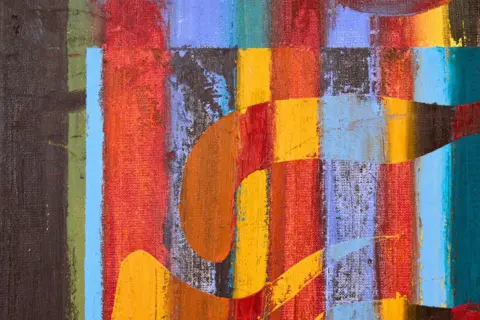 Rocio Chacon / Ed Cross Gallery
Rocio Chacon / Ed Cross GalleryHe comes from an influential family of financiers and chiefs in the south-central Ashanti region of Ghana.
The ancestral home is very close to Bonwire, the birthplace of the world-famous kente fabric, and the artist grew up wearing the traditional multi-coloured cloth.
He also learned how to weave it using a hand loom, stripe by stripe, colour by colour - a process that he finds “cathartic and meditative”.
His paintings are reminiscent of kente cloth, and the process has, he says, been “almost like weaving with paint”.
"It’s super interesting to see how my heritage has manifested itself in my work – beyond the way in which it obviously addresses my battle with depression.”
The exhibition How’s Your Day Going? by Joseph Awuah-Darko is on at Ed Cross Fine Art in London until 19 October 2024.
You can find out more about bipolar disorder here
You may also be interested in:
 Getty Images/BBC
Getty Images/BBC


 Africana55 Radio
Africana55 Radio 

